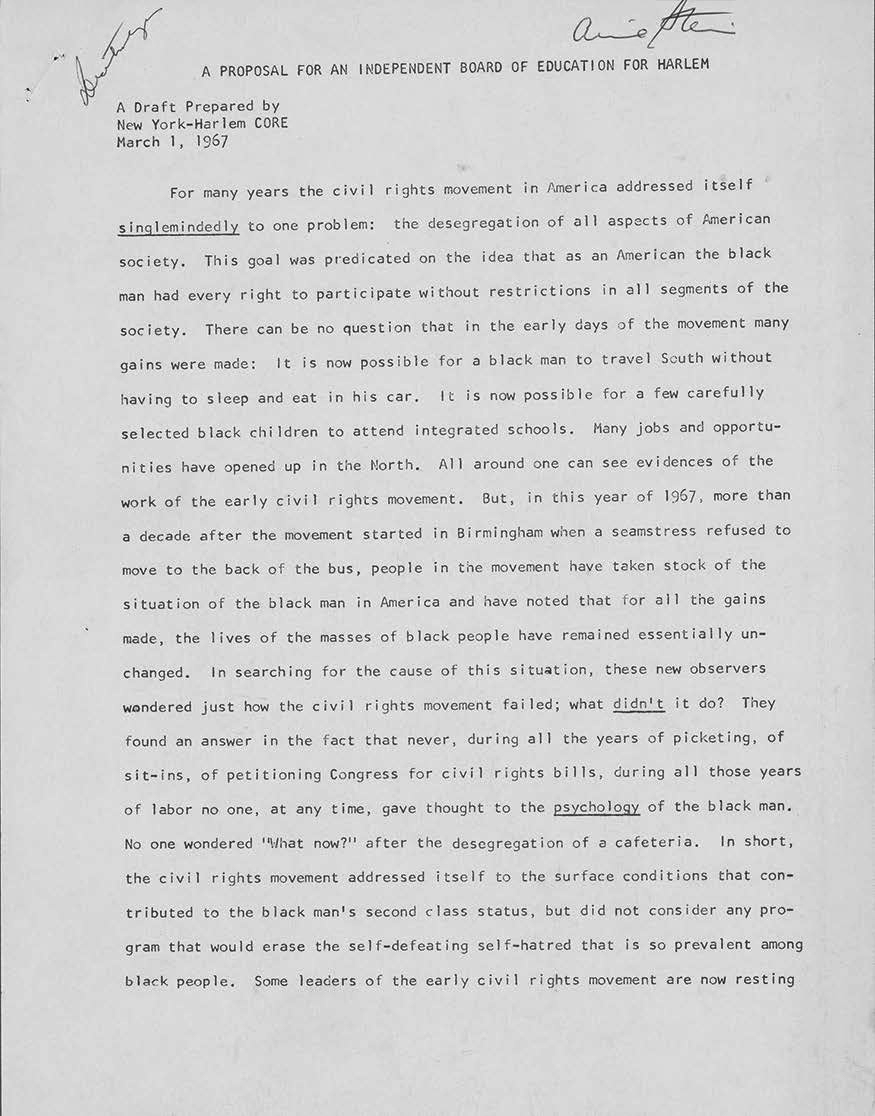You are here:
A Proposal for an Independent Board of Education in Harlem

Date: Mar 1, 1967
Caption: This excerpt comes from the Harlem chapter of the Congress of Racial Equality’s (CORE) proposal for an independent school Board of Education in Harlem in 1967.
Over 1 million new Black Southern migrants and Puerto Rican immigrants had settled in New York City by the 1950s. Most resided in Harlem, the South Bronx, and Central Brooklyn. They faced many barriers, including poverty and discrimination in employment and housing discrimination, and often attended schools that the Board of Education had long neglected. The city’s centralized school system had often ignored Black residents’ demands while prioritizing the needs and wants of white students and their families.1
To address these issues, civil rights groups like the Congress of Racial Equality (CORE) used a variety of tactics to equalize access to opportunities throughout New York City. Founded in Chicago in 1942, CORE gained national prominence when it initiated the Freedom Rides campaign in the South in 1961. The organization was also active in challenging housing and schooling segregation in the North, and as this document shows, rejected the idea that segregation was a southern problem alone.2
In 1967, after other Harlem organizations had protested to improve their neighborhood schools for decades, the Harlem branch of CORE took a new approach. They drafted a proposal to establish an independent local school board in Harlem to govern public schools there. They sought to fully remove Harlem schools from the New York City school system, and establish Harlem residents’ control over their own schools. The proposal reflected the interest among many Black and Latinx New Yorkers at the time in educational self-determination.
-
Matthew Delmont, Why Busing Failed: Race, Media, and the National Resistance to School Desegregation (Oakland: University of California Press, 2016). See also: Matthew Delmont, Why Busing Failed, accessed April 10, 2024, whybusingfailed.com. ↩︎
-
For more on CORE in NYC, see Brian Purnell, Fighting Jim Crow in the County of Kings: The Congress of Racial Equality in Brooklyn (Louisville: University Press of Kentucky, 2015). ↩︎
Categories: K-12 organizing, Manhattan, community activism
Tags: Harlem, self-determination, democracy, school administration, North and South
This item is part of "The Push for Community Control" in "Who Governs Schools?"
Item Details
Date: Mar 1, 1967
Creator: Harlem CORE
Source: Annie Stein Papers, Columbia University Rare Book and Manuscript Library, Box 9, Folder 14.
Copyright: Public domain
How to cite: “A Proposal for an Independent Board of Education in Harlem,” Harlem CORE, in New York City Civil Rights History Project, Accessed: [Month Day, Year], https://nyccivilrightshistory.org/gallery/proposal-independent-boe-harlem.
Questions to Consider
- How does CORE describe segregation in this document? In their view, what makes community control of schools a powerful challenge to segregated schooling?
- CORE compares segregation in the North to the South. In what ways does CORE describe segregation in the North as different or similar to that of the South?
- At the end of this document, CORE lists three ways they believe an independent school board in Harlem would bring “about changes needed to improve the schools.” What are those three ways? Do you agree?
References
How to Print this Page
- Press Ctrl + P or Cmd + P to open the print dialogue window.
- Under settings, choose "display headers and footers" if you want to print page numbers and the web address.
- Embedded PDF files will not print as part of the page. For best printing results, download the PDF and print from Adobe Reader or Preview.
